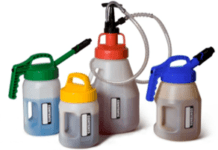
Marcos Thadeu Lobo
Mechanical Engineer Graduated from the State University of Campinas (Unicamp). He is currently an Associate Consultant at QU4TTUOR CONSULTORIA.
Portable containers for lubricants
Portable containers for lubricants – When, for reasons of volume, accessibility or design of the mobile or industrial machinery, it is not possible to apply the filtered lubricating oil directly from the filtration car, it will be necessary to use intermediate portable containers with seals, depending on the application and the volume to be used.
Figures 1/2 – Sealed portable intermediate containers.
Sealed portable intermediate containers must have the following characteristics:
- Specific use for a certain lubricating oil in order to avoid cross contamination.
- Resistant to shocks, chemical attacks and abrasion wear.
Figures 3/4 – Portable intermediate containers with seals must have good mechanical resistance.
- Manufactured with material compatible with the lubricating oils for which they are intended.
- Have airtight lids that can be closed when not in use.
- That do not require the use of funnels.
- Can be inspected and cleaned easily.
- Labeled with information about the specific use for which they are intended.
Advantages of using sealed portable containers for lubricants
:
- Each type of lubricating oil will have its own dedicated portable intermediate container with seal, minimizing the risk of cross contamination and the need to carefully clean the containers each time a different lubricating oil is used.
- It will allow lubricating oils that have been filtered directly from the original containers to be stored without risk of contamination by water or solid particulate matter.
Figures 5/6 – It does not require the use of funnels and if equipped with quick connectors, the lubricating oil can be applied directly to the machinery.
- It will dispense with the use of funnels as the application can be made directly into the filling nozzle of mobile or industrial equipment.
- If equipped with quick connectors, portable intermediate containers with seals will allow the application of lubricating oil directly to the machinery.
- They will give responsibility and seriousness to lubrication work by using dedicated and durable containers.
- They will allow easy identification of the lubricating oils used.
Just having suitable containers does not guarantee the application of best practices in lubrication, it is necessary that they are always clean and that policies are established for cleaning and conservation of containers in order to avoid contamination with water and solid particulate matter. Depending on the conditions of use, portable intermediate containers must be inspected at least every 3 months and if contamination by water or solid particulate material is observed, cleaning must be immediate and complete.
Figures 7/8 – The portable intermediate containers with seal are easy to clean and the filtered oil can be transferred directly from the original container.
It is recommended, to avoid contamination with water and solid particulate matter, that sealed portable intermediate containers follow the following recommendations when filling:
- All lubricating oil that enters the portable intermediate container with seal must undergo a filtration process.
- Sealed portable intermediate containers must be filled in a clean lubrication room or room and in a controlled environment. If the conditions of the place where the filling will be carried out do not satisfy the ideal cleaning conditions, some additional measures must be taken to prevent the entry of moisture or solid particulate material into the sealed portable intermediate containers when filling. A plastic bag or polyethylene film used in food preservation can be used to cover the mouth of the Portable Intermediate Container with seal at the time of filling, piercing the plastic with the end of the lubricating oil transfer hose.
Figures 9/10 – The environmental conditions in which portable intermediate containers with seals are filled are of vital importance.
- Keep containers hermetically closed at all times and only open them in controlled environments when inspection and filling is required.
Figures 11/12 – Keep containers hermetically closed.
- If the sealed portable intermediate container has a vacuum control device, it is important to keep it closed until use.
- Immediately clean the exterior of sealed portable intermediate containers whenever necessary to prevent dirt build-up.
- Replace sealed portable intermediate containers if the structure fails due to fatigue, corrosion or abrasion.
- Keep the labels in good condition, replacing them whenever necessary.


























